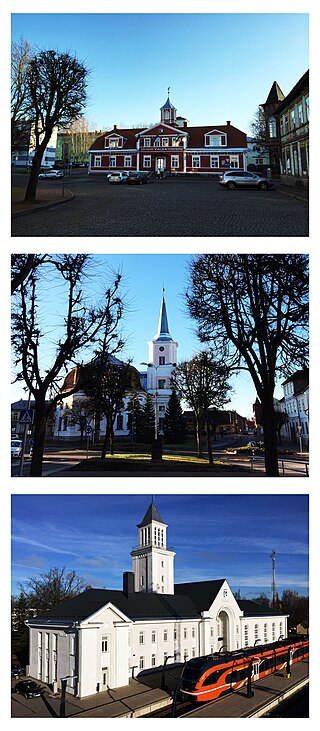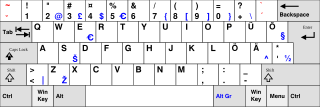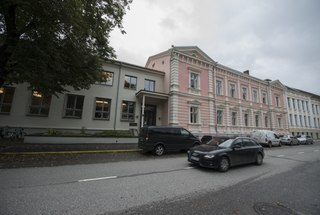
Estonian is a Finnic language of the Uralic family. Estonian is the official language of Estonia. It is written in the Latin script and is the first language of the majority of the country's population; it is also an official language of the European Union. Estonian is spoken natively by about 1.1 million people: 922,000 people in Estonia and 160,000 elsewhere.

Ingria is a historical region in what is now northwestern European Russia. It lies along the southeastern shore of the Gulf of Finland, bordered by Lake Ladoga on the Karelian Isthmus in the north and by the River Narva on the border with Estonia in the west. The earliest known modern inhabitants of the region were indigenous Finnic ethnic groups, primarily the Izhorians and Votians, who were forcibly converted to Eastern Orthodoxy over several centuries during the late Middle Ages. They were later joined by the Ingrian Finns, descendants of 17th century Lutheran Finnish immigrants to the area. At that time, modern Finland proper and Ingria were both part of the Swedish Empire.

Votic or Votian, is a Finnic language spoken by the Votes of Ingria, belonging to the Finnic branch of the Uralic languages. Votic is spoken only in Krakolye and Luzhitsy, two villages in Kingiseppsky District in Leningrad Oblast, Russia. In the 2020–2021 Russian census, 21 people claimed to speak Votic natively, which is an increase from 4 in 2010. Arvo Survo also estimated that around 100 people have knowledge of the language to some degree.

Votians, also referred to as Votes, Vots and Vods are a Finnic ethnic group native to historical Ingria, the part of modern-day northwestern Russia that is roughly southwest of Saint Petersburg and east of the Estonian border-town of Narva. The Finnic Votic language spoken by Votians is close to extinction. The language is still spoken in three villages of historical Votia and by an unknown number of speakers in the countryside. The villages are Jõgõperä (Krakolye), Liivcülä (Peski), and Luuditsa (Luzhitsy). In the Russian 2020 census, 99 people identified as Votian.

Valga is a town in southern Estonia and the capital of Valga County and Valga Parish. Until their separation in 1920, Valga and the town of Valka in northern Latvia were one town. They are now twin-towns. The area of Valga is 16.5 square kilometres and that of Valka is 14.2 km2 (5.5 sq mi). Their populations are respectively 12,261 and 6,164. On 21 December 2007 all border-crossing points were removed and roads and fences opened between the two countries with both countries joining the Schengen Agreement.

Ingrian, also called Izhorian, is a Finnic language spoken by the Izhorians of Ingria. It has approximately 70 native speakers left, most of whom are elderly.
The exessive case is a grammatical case that denotes a transition away from a state. It is a rare case found in certain dialects of Baltic-Finnic languages. It completes the series of "to/in/from a state" series consisting of the translative case, the essive case and the exessive case.

The official language of Estonia is Estonian, a Uralic language of the Finnic branch, which is related to Finnish. It is unrelated to the bordering Russian and Latvian languages, both of which are Indo-European.
The Learned Estonian Society is Estonia's oldest scholarly organisation, and was formed at the University of Tartu in 1838. Its charter was to study Estonia's history and pre-history, its language, literature and folklore.

Oskar Kallas was an Estonian diplomat, linguist and folklorist. He was the husband of the Finnish writer Aino Kallas.

The northeastern coastal dialect is a Finnic dialect traditionally considered part of the Estonian language. The Estonian coastal dialects were spoken on the coastal strip of Estonia from Tallinn to river Narva. It has very few speakers left nowadays.

Estonia, officially the Republic of Estonia, is a country by the Baltic Sea in Northern Europe. It is bordered to the north by the Gulf of Finland across from Finland, to the west by the sea across from Sweden, to the south by Latvia, and to the east by Lake Peipus and Russia. The territory of Estonia consists of the mainland, the larger islands of Saaremaa and Hiiumaa, and over 2,300 other islands and islets on the east coast of the Baltic Sea, covering a total area of 45,335 square kilometres (17,504 sq mi). Tallinn, the capital city, and Tartu are the two largest urban areas. The Estonian language is the official language and the first language of the majority of the population of 1.4 million.

The Estonian Folklore Archives (EFA) is the central folklore archives in Estonia. The Archives functions currently as the subdivision of the Estonian Literary Museum but it was established in 1927 as the division of the Estonian National Museum. The current Head of the Archives is Dr. Risto Järv.

Ilmar-Aleksander Talve was an Estonian writer and ethnologist. He worked primarily in Sweden and Finland.

Felix Johannes Oinas was an Estonian folklorist, linguist, and translator.

The Kukkuzi dialect or Kukkusi dialect (Куровицы) is a dialect of Votic spoken in Kukkuzi. The Kukkuzi dialect has been heavily influenced by Ingrian.

Tiit-Rein Viitso was an Estonian linguist.
Paul Alvre was an Estonian linguist.
Helmi Mäelo was an Estonian writer and social figure, the initiator of Mother's Day celebrations in Estonia.
Mother Tongue Society is an Estonian organization that focuses on topics related to the Estonian language.













